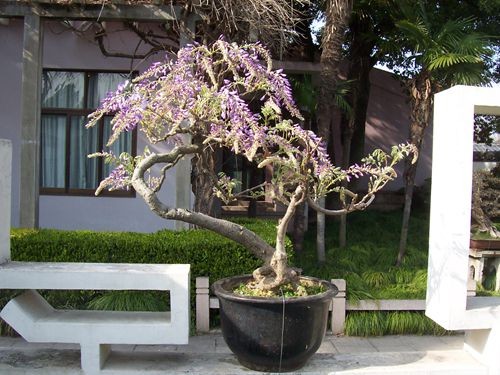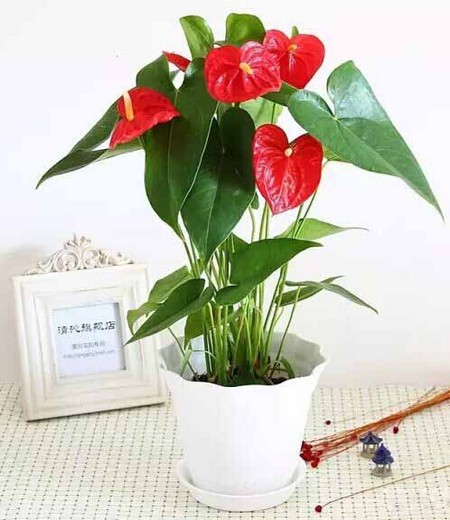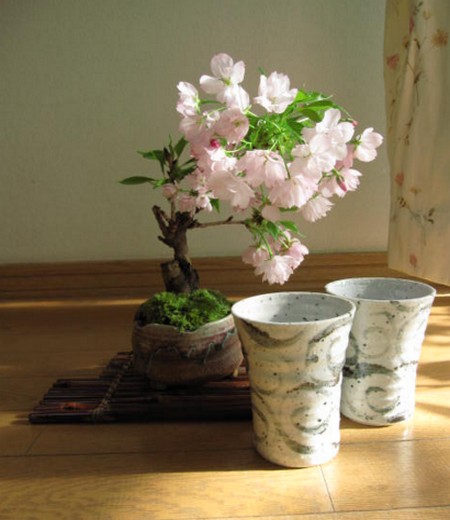Pruning technique of wisteria bonsai
The common shapes of wisteria bonsai are curved dry type, oblique dry type, hanging branch type, cliff type, water-facing type, stone-attached type and so on. Different shapes can be selected according to different forms of tree stump. Because of its large leaves, the crown is often natural, and does not have to be tied into a cloud shape. The modeling method is mainly pruning, supplemented by appropriate flat binding and traction. Can also use Qiu qu simple old wisteria stakes as rootstocks, with small leaves, flowering Japanese wisteria and other excellent varieties as scions, grafting, so that the production of bonsai more ornamental and artistic.

Crape myrtle is resistant to pruning and can be cut to a tree that is higher than the tree and has a low dry round head. By means of heavy cutting or even sawing, it is effective to control the height and shape of the crown, and the germination school can blossom in the same year. Cut off the inflorescence in time after flowering to save nutrients and be conducive to flowering next year.
The main purpose of dormant pruning is to adjust the rattan type, make its growth trend fixed, properly thinning branches to facilitate the use of nutrition space, and delete some non-flowering branches. Post-anthesis pruning can use strong pruning of branches in the first year and erasing too many sprouts to properly reduce the height and ensure the shrub shape and the growth of a sufficient number of strong branches in the same year. After autumn, the branches were properly cut and thinned before flower bud differentiation, so as to retain the lower buds of long branches and differentiate into flower buds.
After the defoliation in winter, the plant is pruned comprehensively, the dry and dead branches are cut off, and the branches of the current year are cut short by 1 to 2, so that they are different in length and scattered. Winter moves to the cold room or overwinters in the outdoor shelter from the wind and the sun, keeping the basin soil free of ice to survive the winter safely. After sprouting in spring, the over-dense buds are wiped out in time, so that nutrients are concentrated on the remaining branches, which is beneficial to flowering.
It has the advantages of fast growth, long life and strong winding ability, so special attention should be paid to shaping and pruning in its growth process. After the wisteria was planted, the strong branches were selected as the main vine culture, and the immature part of the apex was cut off. If there are side branches at the cut, cut off 2 or 3 branches to reduce competition and make it easier to wrap the main vine around the pillar. In addition to sending out a strong central main branch on the trunk, several new branches will be sent out to support the central main branch, which should be removed in batches. In the following winter, the central main branch on the shelf will be short to the strong bud, in case it will send out a strong main branch in the coming year. Two buds were left under the strong buds and cultured as the second and third main branches. After the wisteria skeleton is finalized, the dead branches, disease and insect branches and overtwined overlapping branches should be cut off every winter.
General lateral branches, leaving 2 to 3 buds truncated, so that the distribution of branches on the shelf is uniform. Wisteria grows faster, the vines will become denser and heavier, so they should be thinned before sprouting in winter or early spring to maintain a reasonable density. Wisteria and winding ability is very strong, will strangle other plants, so we should pay attention to prevent vines on the tree, timely artificial traction of individual branches. The flower bud differentiation of wisteria usually begins in early June, such as pruning after flowering, it will affect the formation of flower buds in the following year, so wisteria is generally not pruned in summer. Even pruning only removes overdense branches that affect light and tree shape, while flowering inflorescences should be cut off from the base to prevent pods from consuming nutrients. Wisteria can also be potted or make stump bonsai, usually should pay attention to strengthen pruning and heart-picking, control plant shape and size. When the new shoot is about 15 cm long every year, you should pick the heart once, and you can cut it again after flowering.
In classical gardens, wisteria is often arranged beside the rockery, so it is necessary to strengthen traction when young, so that the vines cling to the stone through chisels. After the adult plant should be strengthened pruning, so that the vines tangled, buckling meandering, like a dragon tossing, string of rattan flowers drooping, lovable, do not have a scene.
Time: 2019-06-11 Click:
- Prev

Propagation methods and matters needing attention of Anthurium andraeanum
Candle and its flowers of the same genus are new cut flowers and potted flowers at home and abroad. each flower can bloom for up to one month and blossom all the year round. Because the flower bud of candle is gorgeous, the plant is beautiful, and the viewing period is long, the market demand increases. Potted flowers are often decorated in indoor coffee tables and desks.
- Next

Propagation Technique of Cherry Blossom in Pot--Cutting Method
Cherry belongs to deciduous tree of Rosaceae, plant height 5~25cm, composed of 3~5 flowers umbrella or raceme, color has white, pink, single or double petals, flowers and leaves at the same time or flowers first and then leaves, flowering 4-5 months. When spring flowers bloom, flowers are full of trees, competing for beauty, anthocyanins are fresh and elegant
Related
- Fuxing push coffee new agricultural production and marketing class: lack of small-scale processing plants
- Jujube rice field leisure farm deep ploughing Yilan for five years to create a space for organic food and play
- Nongyu Farm-A trial of organic papaya for brave women with advanced technology
- Four points for attention in the prevention and control of diseases and insect pests of edible fungi
- How to add nutrient solution to Edible Fungi
- Is there any good way to control edible fungus mites?
- Open Inoculation Technology of Edible Fungi
- Is there any clever way to use fertilizer for edible fungus in winter?
- What agents are used to kill the pathogens of edible fungi in the mushroom shed?
- Rapid drying of Edible Fungi

